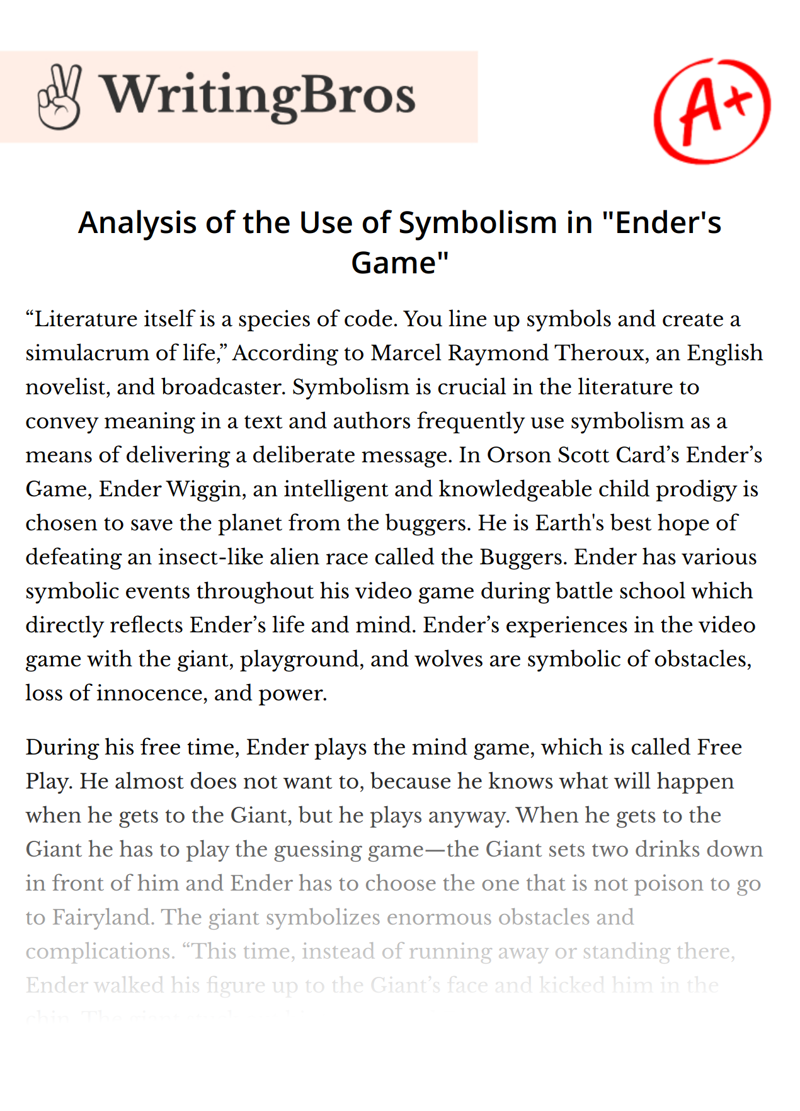Analysis of the Use of Symbolism in "Ender's Game"

“Literature itself is a species of code. You line up symbols and create a simulacrum of life,” According to Marcel Raymond Theroux, an English novelist, and broadcaster. Symbolism is crucial in the literature to convey meaning in a text and authors frequently use symbolism as a means of delivering a deliberate message. In Orson Scott Card’s Ender’s Game, Ender Wiggin, an intelligent and knowledgeable child prodigy is chosen to save the planet from the buggers. He is Earth's best hope of defeating an insect-like alien race called the Buggers. Ender has various symbolic events throughout his video game during battle school which directly reflects Ender’s life and mind. Ender’s experiences in the video game with the giant, playground, and wolves are symbolic of obstacles, loss of innocence, and power.
During his free time, Ender plays the mind game, which is called Free Play. He almost does not want to, because he knows what will happen when he gets to the Giant, but he plays anyway. When he gets to the Giant he has to play the guessing game—the Giant sets two drinks down in front of him and Ender has to choose the one that is not poison to go to Fairyland. The giant symbolizes enormous obstacles and complications. “This time, instead of running away or standing there, Ender walked his figure up to the Giant’s face and kicked him in the chin. The giant stuck out his tongue and Ender fell to the ground.”(63). Throughout the book, Ender has had multiple obstacles, like his brother Peter, Stilson, Bernard and Bonzo. He was always being tormented. Growing up as a third was extremely challenging for Ender. He always teased by his classmates and especially by his brother Peter. “This game tells filthy lies. I am not Peter. I don’t have a murder in my heart. And then a worse fear, that he was the killer, only better than Peter ever was.” (118). The obstacles presented by the giant is symbolic of the constant reminder that Ender has Peter in him. Ender is left with the nagging fear and suspicion that he may actually be a killer like his brother and that he is slowly but surely being fashioned into precisely the killer that is needed to triumph in the bugger wars and save humanity. The giant in the video game is one symbolism that Orson Scott Card used to symbolize obstacles and difficulties; however, the author uses more symbolism such as the playground to show Ender’s loss of innocence.
In the video game after killing the Giant, Ender comes across the playground. Ender then notices something. His avatar is now a child, and he is a smaller child than all of the other children present. He also notices that he is not capable of playing on the playground. The playground symbolizes and youth. “He had not to slide for a moment when he fell right through the slide and landed on the ground under the ladder.”(71). Ender was forced to go to Battle School at the age of six, so he never grew up with toys or with friends playing like other kids. “It was not his fault he was a Third. It was the government’s idea, they were the ones who authorized it.”(5). The playground in the video game and Ender incapable of sliding down the playground is similar to Ender’s loss of innocence and negligence. The government primarily did not give Ender a choice since he was a Third. He was chosen for a reason which gave Ender no childhood and adolescence. The Giant and playground play a significant role in Ender’s life; However, other video game symbols such as wolves also play an important role in Ender’s real world.
After he leaves the playground, Ender wanders into a forest where the children transform into wolves and kill him. Ender figures out that he needs to drown them one by one to move on. The wolves symbolize power and capability. “Each time, the body sizzled as though the water were acid; the wolf was consumed, and a dark cloud of smoke arose and drifted away.”(72). Ender Wiggin is especially divergent and skilled compared to other kids in Battle School. Throughout his experiences in Battle School, Ender has been bullied and tortured and people like Bernard and Bonzo Madrid show why not to trust them. “All Ender could see was the empty, dead look in his eyes. He was already finished then. Already unconscious. His eyes were open, but he wasn’t thinking or moving anymore, just that dead, stupid look on his face, that terrible look, the way Stilson looked when I finished with him.” (212). The wolves killing Ender in the video game is similar to Ender killing Bonzo Madrid in the real world. Although Ender gets bossed around, he is not scared to stand up for himself and defend himself.
Orson Scott Card, Ender’s Game provides many examples of symbolism to make the novel more interesting and fascinating. The author uses three symbolisms, the Giant, playground, and the wolves to develop Ender Wiggin’s character and to show the readers a deeper meaning of what they symbolize. Orson Scoot Card uses the Giant to symbolize obstacles Ender faced throughout the book, the playground to symbolize Ender’s loss of innocence at being a Third and the wolves to represent power and strength.
Cite this Essay
To export a reference to this article please select a referencing style below

